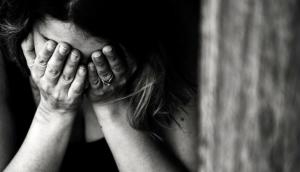
Hijra. A word that at once instills fear and loathing in some, and freedom and self expression in others. It is a name proudly worn by a community that lives on a fringes of society, othered by the virtue of not falling into a binary - the binary of man and woman.
While the Hijra community biologically finds itself being identified as transgender, culturally they are indigenous to the Indian subcontinent. Due to years of being denied basic fundamental rights, the Hijras have often resorted to illegal methods to reclaim their space. At times, these methods border on harassment, like exposing genitals, barging into private property, extorting money, etc.
Also read - This TG model's gown is made of flags from anti-gay nations. Including India
Unfortunately, due to this, the entire Hijra community, which already has little or no contact with mainstream society, is seen as a cult of street criminals. And therefore, transgenders in India, due to the high visibility of Hijras and their perceived culture, feel the need to distance themselves from them.
While this distancing can be established through debate, it also, despite the recent recognition provided to all transgender groups in India, excludes the Hijra voice from the gender conversation. And if the debate is being carried out through a photo series titled #IamNotAHijra with all the problematic stereotypes being thrown right back into the cesspool, it undoes all efforts done to reintegrate the Hijra community in society.

So what if I Am Not A Hijra?
The offending photo series in question was an attempt by the group Transgender India to help Indian trans voices to separate their identity from the Hijras, to reestablish that "I am a trans person. I am as normal as you. And I am not a Hijra." But while it is extremely important to educate Indians about how there are different types of trans people, and that not every one of them is a Hijra, this photo series does so by reinforcing damaging stereotypes about the Hijra community.
First published by The Better India (and later taken down), the series was subsequently shared by BuzzFeed and The Logical Indian. All these publications applauded Transgender India's efforts in normalising transgender Indians, but failed to identify that it did so by further stigmatising the Hijra community. While it is easy to sound 'holier than thou' at this point, the problem doesn't quite lie with the said publications writing about the photo series, it lies in the virality of the subject.

The speed at which the series is being shared goes to show the silence of the Hijra community, the abject lack of representation and the complete whitewashing of an entire community as uncouth and, therefore, worthy of being shunted.
Also read - Ka Bodyscapes and CBFC's fixation with banning socially relevant films


Vyjayanti Vasanta Mogli from Telangana Hijra Samiti thinks these are "ad hominem attacks" and stem from "logical fallacies".
Upset at how strongly some trans persons are supporting this divide, Mogli, in a conversation with Catch said, "We cannot awaken people who pretend to be sleeping. It's only with time that they'll realise they've stabbed themselves."
"They are hopeful the society will place them on the pedestal but that's not happening," she added.
Talking about how the Hijra community is perceived, Mogli says, "Hijra people clap and harass. Some do, not all."
"But Hijra people clapping and harassing men is just a symptom of the larger problem. It's the tip of the iceberg. If we just look at symptoms, how will we ever diagnose the problem?" she asks, pointing to how the community has always been kept isolated from society.


Some of these placards say "I have also been raped/Not a Hijra" or "Not a prostitute/Not a Hijra". These pictures basically rob the Hijra community of how real their vulnerabilities are and objectifies them into being one disembodied entity, one big black hole. A noun nobody wants to associate with.
"Hijra is a noun? Who said so?" asks Mogli.
"It's also an adjective. When girls who have a certain rapport with each other and say 'ari', 'aari' or 'a jaari', it's a very different thing. It's different when a Hijra recognizes a friend as Hijra. It's like when your friends have certain names for you, like darling or sweetie. Strangers can't appropriate that, can they?"
Does this stem out of hate?
While a disturbing number of people have shared the photo series, applauding Transgender India's initiative, a handful of people have objected to the project. LGBTI activist Romal Laisram, one of the people instrumental in making The Better India reconsider their article, has been fighting his own war on Facebook.
A measured counter-comment made by Gina V Victoria under this reads, "The gist is there are forces that have been at work to make only hijra the face of transgender community in India. And they're mostly right wing.
"You can also see this how that conservative thought was reflected on the [Transgender rights] bill in lok saba (sic.).
Hence the disclaimer at the end about how it's not about negating hijra. But they who started this wish to bring out into public opinion that there are other gender facets and even binary men and women in the umbrella term.
"Anyway, I didn't know then what it was all about. I still don't know if this is a good approach. But I can say, I think, their motivations weren't hatred."
Also read - Brazil's LGBT murder epidemic: one person killed every day


Laisram agrees that it is important to differentiate the Hijra from the non-Hijra trans person, but he isn't convinced that the motivations here don't stem from hatred.
While talking to Catch, he said, "Non-Hijra transcommunities in India have always felt overshadowed by the presence of an over-enthusiastic obsession with the Hijra community. This has stemmed from a self-propagating politic practiced by certain groups within the Hijra community and a lack of active interest from the media fraternity. The problem has always been there."
"However, resorting to maligning the Hijra community by shaming them, underplaying their abilities and slandering their characteristics, also passing high-handed moral judgements - all in the name of differentiating from them - is absolutely unnecessary and uncalled for."
Distraught at how regressive and divisive the campaign is, Laisram says, "The Indian media is also obsessed with vilifying the Hijra community. So now that you have another transcommunity that reflects your deep-seated Hijraphobia... you quite happily jump onto the bandwagon and call it advocacy. How in the world can someone call implications of all Hijras being sex maniacs and all Hijras being incapable of being mothers, sisters and daughters... anything but pure and vile hatred?"
More social media wars
Ani Dutta started the debate with her post against The Better India article on 16 August. Her post reads,
"So here comes transgender respectability politics, Indian version: trans persons are also corporate employees, earn six-figure salaries, are not sex workers, are not 'confused' about their gender, and most importantly (of course), are not Hijras (Goddess forbid that anyone should think them so!) What next - this trans vanguard 'saving' their unfortunate hijra / sex worker brethren from their fallen ways? As if propping up violent institutions like corporates-NGOs-academia or the Indian nation state (which many of us are compelled to compromise with) was not enough, now some of us must also claim credit for 'breaking stereotypes' through our complicities!"
While most comments spew venom under her post, Dipanjan Chattopadhyay hits the nail on the head.
"As individuals, they are free to distance themselves from the hijra community. But the problem is they are *contrasting* the hijra community with positive words and phrases such as "surgeon", "six-figure income", "mother", "wife", "daughter", "tax-payer", "corporate employee" , "physical trainer" etc. while *tainting* the community with stereotypical negative words such as "sex maniac", "loose", "make-up" etc.
The heteronormative sexist patriarchal mindset they are protesting is also the root cause of oppression and marginalization of hijra community. How does reinforcing the stereotypes and victim-shaming help them or the community? How is this different from house n****s feeling superior to field n****s, to recall Malcolm X?"
Her post also invited many video comments that show "skirt lifting" and other tropes of "Hijra harassment".
As Mogli says, "The arguments [on Dutta's post] are tenuous, they are weak. They've put videos of Hijra people lifting theirs skirts etc. It's degrading, infantalising."

Hijra =/= Transgender
A proud representative of the Hijra community and a well known face around Jantar Mantar and other protest gatherings, Laxmi Narayan Tripathi is a name to be reckoned with.
Interestingly, at the launch of her autobiography Me Hijra, Me Laxmi at Jaipur Literature Festival 2016, Tripathi said that she doesn't identify much with the term transgender.
While talking to Catch, Tripathi said, "Why do I need an English word [to identify Hijras]?"
"Even in the Supreme Court I've said that I represent the oldest ethnic transgender community which has its own culture, its own religious belief. And we're a community, we live like a family."
Tripathi too, in her own way, distanced herself from being identified as non-Hijra. But she did so by talking about Hijra pride instead of maligning another group's identity.
If distancing oneself is so important, why can't it be through positive reaffirmation? Transgender India should take note.
First published: 19 August 2016, 8:46 IST







![BJP's Kapil Mishra recreates Shankar Mahadevan’s ‘Breathless’ song to highlight Delhi pollution [WATCH] BJP's Kapil Mishra recreates Shankar Mahadevan’s ‘Breathless’ song to highlight Delhi pollution [WATCH]](https://images.catchnews.com/upload/2022/11/03/kapil-mishra_240884_300x172.png)

![Anupam Kher shares pictures of his toned body on 67th birthday [MUST SEE] Anupam Kher shares pictures of his toned body on 67th birthday [MUST SEE]](https://images.catchnews.com/upload/2022/03/07/Anupam_kher_231145_300x172.jpg)






